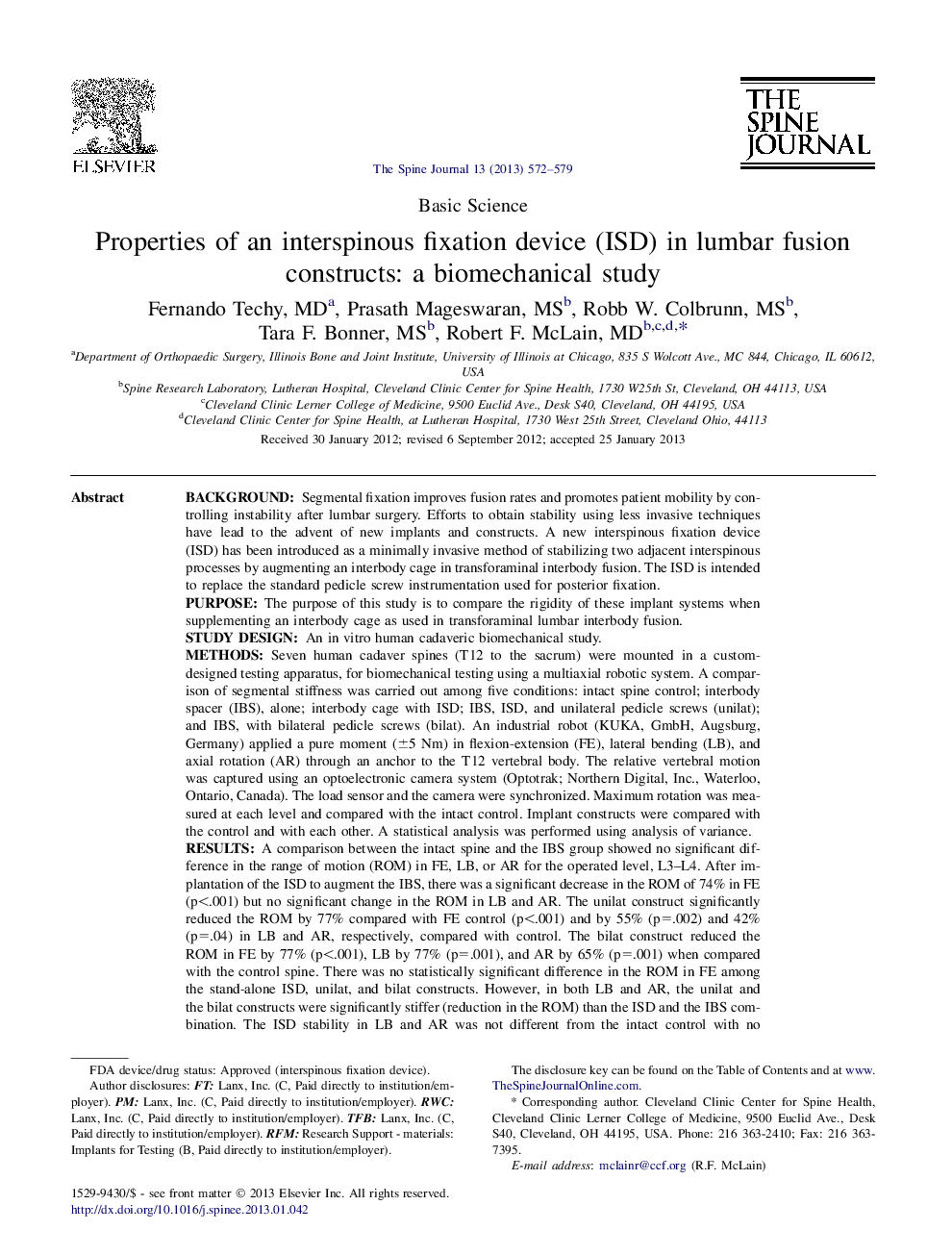| کد مقاله | کد نشریه | سال انتشار | مقاله انگلیسی | نسخه تمام متن |
|---|---|---|---|---|
| 4097840 | 1268599 | 2013 | 8 صفحه PDF | دانلود رایگان |

BackgroundSegmental fixation improves fusion rates and promotes patient mobility by controlling instability after lumbar surgery. Efforts to obtain stability using less invasive techniques have lead to the advent of new implants and constructs. A new interspinous fixation device (ISD) has been introduced as a minimally invasive method of stabilizing two adjacent interspinous processes by augmenting an interbody cage in transforaminal interbody fusion. The ISD is intended to replace the standard pedicle screw instrumentation used for posterior fixation.PurposeThe purpose of this study is to compare the rigidity of these implant systems when supplementing an interbody cage as used in transforaminal lumbar interbody fusion.Study designAn in vitro human cadaveric biomechanical study.MethodsSeven human cadaver spines (T12 to the sacrum) were mounted in a custom-designed testing apparatus, for biomechanical testing using a multiaxial robotic system. A comparison of segmental stiffness was carried out among five conditions: intact spine control; interbody spacer (IBS), alone; interbody cage with ISD; IBS, ISD, and unilateral pedicle screws (unilat); and IBS, with bilateral pedicle screws (bilat). An industrial robot (KUKA, GmbH, Augsburg, Germany) applied a pure moment (±5 Nm) in flexion-extension (FE), lateral bending (LB), and axial rotation (AR) through an anchor to the T12 vertebral body. The relative vertebral motion was captured using an optoelectronic camera system (Optotrak; Northern Digital, Inc., Waterloo, Ontario, Canada). The load sensor and the camera were synchronized. Maximum rotation was measured at each level and compared with the intact control. Implant constructs were compared with the control and with each other. A statistical analysis was performed using analysis of variance.ResultsA comparison between the intact spine and the IBS group showed no significant difference in the range of motion (ROM) in FE, LB, or AR for the operated level, L3–L4. After implantation of the ISD to augment the IBS, there was a significant decrease in the ROM of 74% in FE (p<.001) but no significant change in the ROM in LB and AR. The unilat construct significantly reduced the ROM by 77% compared with FE control (p<.001) and by 55% (p=.002) and 42% (p=.04) in LB and AR, respectively, compared with control. The bilat construct reduced the ROM in FE by 77% (p<.001), LB by 77% (p=.001), and AR by 65% (p=.001) when compared with the control spine. There was no statistically significant difference in the ROM in FE among the stand-alone ISD, unilat, and bilat constructs. However, in both LB and AR, the unilat and the bilat constructs were significantly stiffer (reduction in the ROM) than the ISD and the IBS combination. The ISD stability in LB and AR was not different from the intact control with no instrumentation at all. There was no statistical difference between the stability of the unilat and the bilat constructs in any direction. However, LB and AR in the unilat group produced a mean rotation of 3.83°±3.30° and 2.33°±1.33°, respectively, compared with the bilat construct that limited motion to 1.96°±1.46° and 1.39°±0.73°. There was a trend suggesting that the bilat construct was the most rigid construct.ConclusionsIn FE, the ISD can provide lumbar stability comparable with Bilat instrumentation. It provides minimal rigidity in LB and AR when used alone to stabilize the segment after an IBS placement. The unilat and the more typical bilat screw constructs were shown to provide similar levels of stability in all directions after an IBS placement, though the bilat construct showed a trend toward improved stiffness overall.
Journal: The Spine Journal - Volume 13, Issue 5, May 2013, Pages 572–579